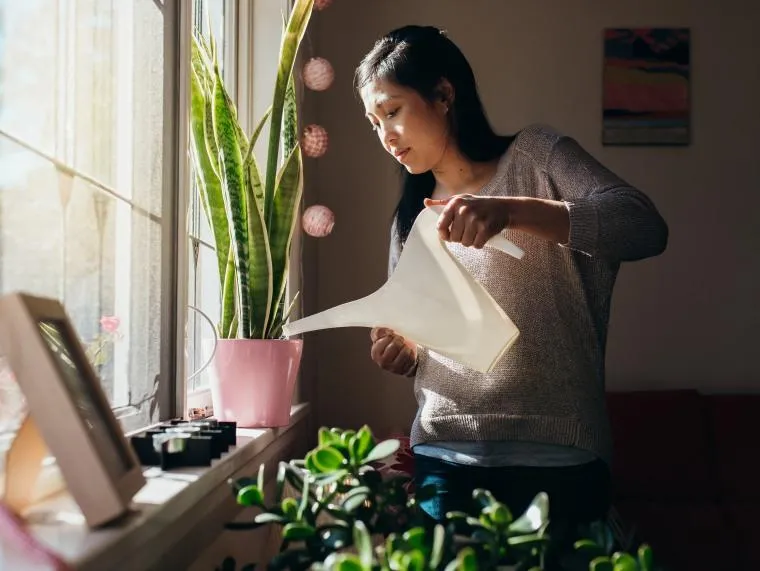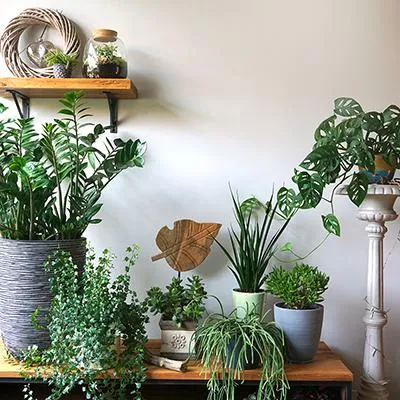Top Indoor Plants That Thrive With Minimal Care
Whether you have a brown thumb or just don’t have a lot of time to tend to plants, choosing the right low-maintenance greenery is key to keeping your indoor jungle alive. From my own experiences trying to keep plants alive inside my tiny apartment, I’ve learned that some species are definitely more forgiving than others when it comes to the care they need.
Pothos
- Golden pothos
- Marble queen pothos
- N’Joy pothos
Basically, pothos is one of the easiest plants to keep alive indoors. These vining plants like golden, marble queen, and N’Joy pothos can thrive with very little water or sunlight. You could even forget to water a pothos for weeks on end and it’ll still be grinning back at you, begging for another drink. Pothos are so low maintenance that they’ve become kind of known as the “invincible” plant among folks with a brown thumb like myself. Even if you have a black spot for keeping plants alive, pothos will probably cut you some slack. They’re amazing.
Snake Plant
Another rockstar plant for neglectful plant parents is the snake plant. These tall grass-like plants with stiff upright leaves are about as undemanding as plants get. Snake plants can go weeks without water and suffer little ill effects. They also tolerate very low light conditions. You can stick a snake plant practically anywhere, forget about it, and it will be perfectly fine, thank you very much. These resilient plants can go above and beyond to survive – I’ve read stories online of snake plants pushing through concrete! If that’s not a testament to their tough-as-nails nature, I don’t know what is.
Chinese Evergreen
Related to peace lilies, Chinese evergreen is another great pick for beginners. These attractive foliage plants come in an array of colors from golden-yellow to deep burgundy and green. They prefer moderate indirect light and average soil moisture. Chinese evergreen leaves will develop brown and curled edges if the soil is too dry for too long. So water when the top inch of soil feels dry. Other than that, these elegant plants are pretty low fuss. With their lush leaves and ability to survive typical neglect, Chinese evergreen is a nice choice to liven up any room.
ZZ Plant
Also called Zanzibar gem, this is another tough customer in the plant world. ZZ plants can handle low light conditions with ease. They also generally go a long time between waterings thanks to their thick succulent-like leaves that store water. Sometimes I swear I’ve forgotten about my ZZ for a month straight and it’s still going strong, just chilling in the corner being all nonchalant. Their waxy leaves are resistant to browning even in dry air and low humidity. And when they do need water, their leaves will start to look a little limp or deflated as a sign. So if you’re forgetful like me, a ZZ plant is a perfect pick to brighten up your space.

English Ivy
This classic vining plant thrives in medium to low light and can tolerate some neglect when it comes to watering. English ivy’s small rounded leaves and ability to climb make it a nice decorative addition dangling from bookshelves, hanging pots, or trailing over the edge of a table. I have an ivy that has been growing strong for years – it’s basically become the poster child of resilience in my home. English ivy is a great set-it-and-forget-it choice that requires infrequent watering to keep it happily lush.
Factors That Affect Indoor Plant Care Needs
The amount of care an indoor plant needs depends on a few key factors. Different plant species have varying requirements for light, water, humidity and soil drainage. So basically, pay attention to your plant’s natural habitat when deciding how much TLC it requires. For example, a fern that grows in dense rainforests will need more water and humidity than a succulent used to arid conditions. Location within the home also affects light levels plants receive. West and south-facing windows provide the brightest indirect sunlight. Plants placed in north-facing windows or low-light areas may need less frequent watering.
Environmental conditions like temperature and air circulation are kind of important too. Plants adapted for tropical or arid climates may broil or wilt in an overheated indoor space. Make sure to rotate plants as needed to balance growth. It’s also a good idea to monitor plants for signs they need a drink. Wilted or curled leaves usually mean it’s thirsty. On the other hand, soggy soil that stays wet for days is certainly never a good thing either. Proper drainage is key to avoid root rot. Adjust your watering based on moisture level and drainage. Over time, it becomes sort of second nature to read your plant’s signals.
Kind of a tricky part of keeping indoor plants happy is recreating their natural humidity levels. Furnaces and indoor heating tend to dry out hair and skin, not to mention plants. Symptoms of low humidity include crispy leaf edges and brown tipping that doesn’t go away. Using a humidity tray filled with pebbles and water under plants helps raise ambient moisture. Grouping plants together also helps them retain humidity between each other. For extra drama, go for foliage like ferns, prayer plants and begonias that truly shine in humid conditions. Their incredible curled and ruffled leaves will put on quite the show! A little effort with humidity makes all the difference.
So in summary, different species have diverse requirements but light, water, temperature, drainage and humidity all contribute to indoor plant care needs. Match plants to your care abilities and environment. Choose beginner-friendly varieties when stepping into the plant parent scene. Observe how much water and light plants seem happiest with over time. With some trial and error, you’ll become an expert at keeping your whole indoor jungle thriving with much less stress. It’s a fun process.

Monstera Deliciosa
This trendy plant has exploded in popularity in recent years, and for good reason. Monstera’s giant tear-shaped leaves beautifully cut or fenestrated with natural holes are truly stunning. Their tropical vining nature makes them a showstopper hanging from macrame or wrapped around a pole. Monsteras prefer bright indirect light along with high humidity to maintain their amazing foliage texture with large fenestrations. They can tolerate some shade but go months between waterings when cared for properly. If you have the right conditions like high humidity, peace lily-lite soil and brightness without direct sun, monstera deliciosa is a great specimen plant for impressing guests with its dramatic huge leaves. Just be warned, these beauties can become majorly addictive to collect.
Peace Lily
A classic for a reason, peace lilies are pleasing yet tough plants. Their broad upright glossy leaves and statuesque white blooms add beauty to any space. Peace lilies thrive in low to moderate light without direct sun exposure. They indicate thirst by drooping leaves, which perk right back up after a good drink of water. Allow topsoil to dry slightly between waterings. Their dramatic sloping habit also makes peace lilies nice for covering large tabletops or dressers with lush foliage. These plants easily withstand average neglect too, so they’re definitely chill to have hanging around your home. Place one in your bathroom for a hit of greenery that demands little effort to keep content. Peace lilies are ideal set-it-and-forget-it indoor plants.
Does all this talk about selecting plants that match your care style have you itching to try your hand at growing some indoor plants? While some species are definitely more forgiving of the occasional mistake, don’t kids yourself – keeping plants alive does require some work. It takes effort to observe signs of thirst, rotate for balanced growth, address any pest or disease issues, and provide suitable conditions for different foliage. But that effort definitely pays off in the form of beautiful living decor that cleans air and brightens moods. Remember – plants thrive on TLC, so show them some attention and affection. Soon your home will come alive with leafyFriends that will repay your care with years of natural beauty. Now get out there and start shopping for your new plant BFFs!
Top Indoor Plants for Beginners
| Plant | Size | Light Needs | Care Level | Notes |
|---|---|---|---|---|
| Pothos | Any | Low | Easy | Very hardy, tolerate neglect. |
| Snake plant | Any | Low | Easy | Air purifying, tolerate low light. |
| ZZ plant | Any | Low | Easy | Tolerates low light and neglect. |
| Chinese evergreen | Small-Medium | Medium | Easy | Beautiful leaves, toxic to pets. |
| Peace lily | Small-Medium | Medium | Easy | Tolerates low light, signals thirst. |
| Spider plant | Small-Medium | Medium | Easy | Air purifying, produces plantlets. |
FAQ
-
What types of plants grow well indoors?
Many varieties of houseplants can live happily inside. Some easy options are pothos, peace lily, snake plant and Chinese evergreen. These plants don’t need a ton of light or water.
-
Do indoor plants need sunlight?
Most indoor plants require at least some sunlight every day. However, not all plants need direct sun. You can find types that do well in low light conditions like under tree shade. Pothos and snake plants tolerate low light pretty well.

-
How often should indoor plants be watered?
Watering needs vary depending on the plant. During growing seasons, most plants like to stay moist but not soggy. A good rule of thumb is when the top inch of soil feels dry, it’s time to water. Make sure pots have drainage holes so excess water can escape. Overwatering is a common issue.
-
Do indoor plants help clean the air?
Many studies show that certain plants truly are air purifiers. NASA did testing and found plants like gerbera daisies, english ivy and chrysanthemums remove toxins from the air. Pretty amazing how just having some greenery around can work as a natural air filter! And it’s not just air, plants also help reduce stress.
-
What’s an easy indoor plant for beginners?
Pothos and snake plants are extremely simple to care for. They can go quite a while between waterings and don’t mind low light conditions. Peace lilies and Chinese evergreens are also tolerant of various lighting situations. All in all, those are basic plant choices for those still learning how to keep plants content indoors.
-
How do you prevent indoor plant pests?
Keeping plants healthy and inspecting leaves regularly can help avoid issues. Additionally, quarantine any new plants apart from others for a month or so to check for pests. Good hygiene also helps – wiping leaves periodically and changing water. Diatomaceous earth sprinkled on soil acts as a mild pest deterrent too. Prevention is easier than treatment once pests appear.
-
Can indoor plants be toxic to pets?
Unfortunately yes, some common houseplants can be poisonous if ingested by pets. Lilies, dracaena and tulips are toxic to cats. Keep those up high or out of reach. Other plants mildly irritating to skin include ivy, lilies and dieffenbachia. It’s always best to research any plant brought home to be safe around furry family members.

